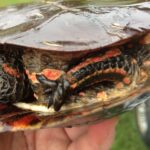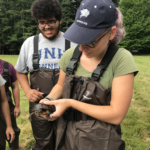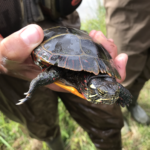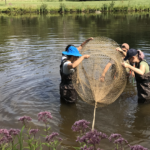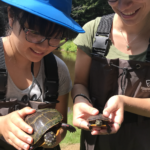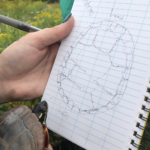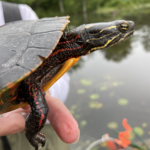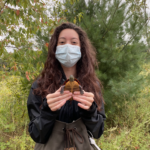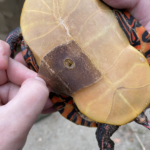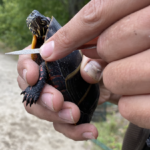Project Leads: Allyson Degrassi (Shenandoah University), Jennifer Purrenhage & Dave Steinberg (University of New Hampshire)
Project E-mail: EREN.turtles@gmail.com
Initiated: 2022
Project Status: Pilot-testing methods in Fall 2022. Accepting new participants for Fall 2023 season.
Description
Effects of landscape context on freshwater turtle population structure in eastern North America
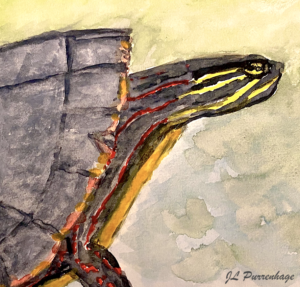
Freshwater turtles are among the most endangered vertebrate taxa worldwide. Many turtle populations have skewed sex ratios and this is often attributed to a range of anthropogenic stressors associated with the type and intensity of land use–i.e., roadkills, increased predator density, and environmental contaminants, all of which can affect sex ratio in complex ways and compromise population viability. The original EREN TurtlePop Project made an important contribution by leveraging the EREN network to surmount spatial restrictions of prior research on this topic, but the authors identified limitations including potential spatial non-independence due to clustering of ponds in certain geographic areas and generally low sampling effort.
In TurtlePop 2.0, participants will trap and mark painted turtles (and co-occurring freshwater turtles) in ‘rural’ and ‘urban’ lentic habitats (ie, ponds). Each participating institution will ideally select 1 ‘rural’ and 1 ‘urban’ trapping location. If a participant/institution does not have access to both rural and urban sites, they will be paired with another institution in the region to achieve our paired rural-urban study design.
Hypotheses/Objectives: TurtlePop 2.0 is designed to address issues identified by previous studies of turtle populations in urbanizing landscapes by implementing a study design using paired urban and rural sites and modifying earlier protocols to increase trapping effort. We expect the bulk of our analyses to focus on the Eastern painted turtle (Chrysemys picta), one of the most ubiquitous species in eastern North America, but the turtles studied in this project may serve as model species for the conservation of other freshwater turtles.
We hypothesize: Turtle populations occupying rural and urban ponds will differ significantly in abundance, sex ratio, and stage/size structure.
Specifically, we predict that:
- P [Abundance]: Urban populations will have lower abundance due to greater turtle mortality in urbanized landscapes.
- P [Sex Ratio]: Urban populations will have a greater proportion of male turtles due to female-biased mortality during overland breeding migrations.
- P [Sex Ratio, alt]: Urban populations will have a greater proportion of female turtles due to environmental drivers such as warming temperatures (leading to greater female recruitment) and/or chemical-driven sex determination (leading to feminization).
- P [Stage/Size Structure]: Urban populations will have a greater proportion of turtles in older/larger stage classes, reflecting an aging population with high female and juvenile mortality.
Summary of Methods:
- Participants sample turtles in 1-2 ponds, each known to support at least a population of Eastern painted turtles.
- Participants trap turtles using small funnel traps (‘minnow traps’) baited with cat food: 10 traps per pond for two trapping sessions (1 trapping session = 2 consecutive trapping nights) per year. Trapping sessions must be separated by at least two weeks and occur during late summer/early autumn (Aug 1 – Oct 1).
- Participants collect the following data during trapping: dorsal and ventral photos, morphological data (carapace length and width, plastron length and width, middle-foreclaw length, pre-cloacal length), and environmental data from study ponds during each visit (e.g., air temp, water temp).
- Participants mark the carapace of each captured turtle with a unique notching code.
- Participants enter data (using the spreadsheet provided), quality-check their data, scan original datasheets, and provide these materials to the project leads at the end of each trapping season.
Expanded Project Info.
Curriculum: Instructor materials, student handouts, and training materials are in development. We’re excited to help you incorporate this project’s protocol and instructional materials into your courses. For now, go to the EREN STEAM Field Notes page for a Turtle Trapping Field Lab/Notebook Assignment based on TurtlePop 2.0.
Other Project Materials:
- Helpful TurtlePop Youtube Videos (TurtlePop 1.0)
- TURTLE POP 2.0 YouTube Channel: Project Meeting Recordings + Training Videos (e.g., setting traps, male vs. female)
Publications from this project will be listed here as available.

